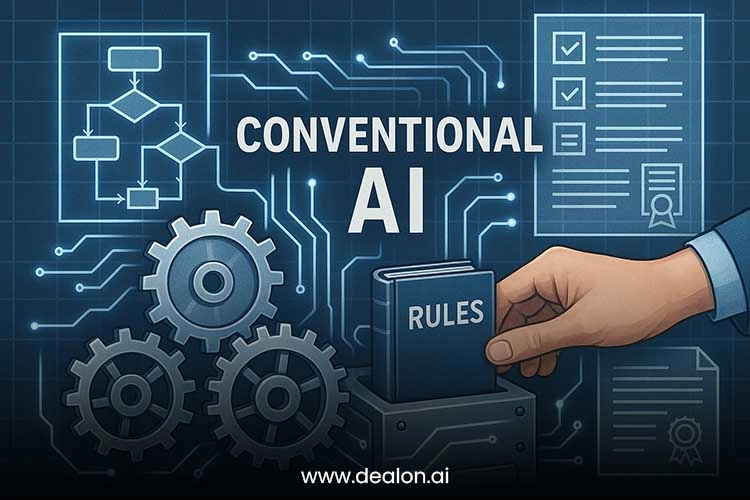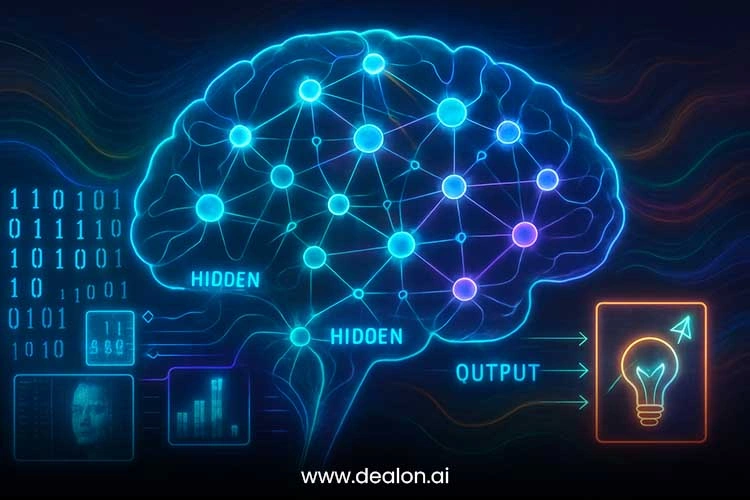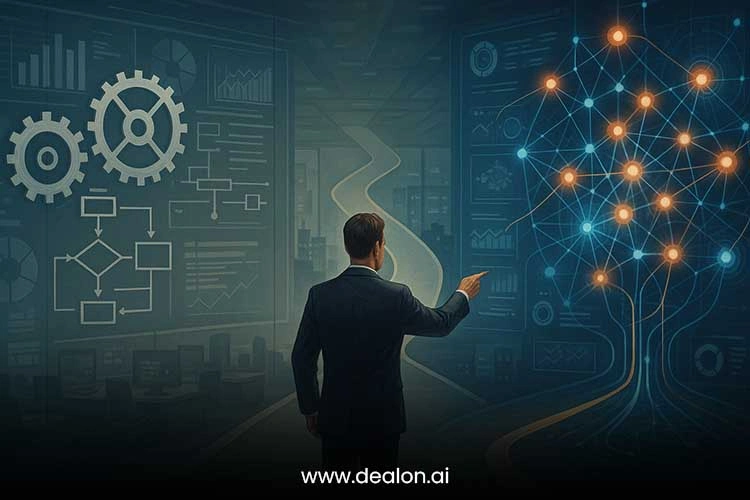With a data-driven approach to business competitors, it is no longer surprising to find more enterprises attempting to derive the benefits that AI can offer them in terms of making decisions, automating operations, and collaborating in new directions. But underlying the sweeping word AI are qualitatively different lines of attack, most important among which are the two lines pitted since the beginning against one another: Traditional AI and Neural Networks. Both belong to the AI category, but they differ significantly in the way they work, the extent to which they can be shaped, and the type of value that they provide.
Conventional AI can also be referred to as traditional AI, symbolic AI, or rule-based AI, which is based on pre-written instructions, logical systems, and structured information. It does very well in unfamiliar, novel situations governed by rules, where transparency and control are paramount. Neural networks, in turn, are the essential components of contemporary machine learning and deep learning systems.
They identify trends or patterns in extensive unstructured data that get honed automatically with time, as they come across new data. Compared to traditional AI, where defining the logic requires the input of a human, neural networks allow the creation of the same complex relationship automatically, allowing the system to create a digital form of cognition.
This difference is more than scholastic. To businesses, it will be a fork in the road of what paradigm of AI to follow, whether the path will be smooth operations or pioneering breakthroughs. Is the priority of one company consistency, interpretability, and compliance, or adaptability, predictive insight, and innovation?
The article discusses the subtle distinction between AI and neural networks in terms of their principles of operation, application areas, and their strengths and weaknesses. In becoming familiar with these distinctions, leaders should be able to make pertinent decisions on what models will best suit their business objectives, data ecosystems, and long-term strategies. As a market increasingly functions as an algorithm, it is essential to be able to differentiate between these two courses of action, not only to keep up but to build a future with intelligent business.
Also Read: Agents vs Chatbots: Which is the Better Tool to Use in Your Business?
Conventional AI: rules, logic, and structured expertise

The classic AI can also be called symbolic AI, that is, the first generation of artificial intelligence, which is constructed around explicit rules, symbolic reasoning, and human logic. Long before machine learning took over the limelight, conventional AI systems had already transformed industries by imbuing years of expert knowledge within the algorithms of a software system.
The more traditional form of AI is determinism. These systems are outcome and consequence: when one set of conditions is fulfilled, a particular kind of action is caused. Traditional AI does not learn, and is the opposite of neural networks; it relies on rules and ontologies that a human expert must carefully craft. It is very powerful in contexts that are stable and where knowledge can be represented explicitly, and where consequences are predictable.
Conventional AI systems tend to use expert systems. These are sets of knowledge bases that consist of facts and rules that are coupled with inference engines that make logical conclusions. They additionally utilize decision trees and rule-based designs, which are typologies that show the routes under conditions and abstractions.
They are finally equipped with symbolic reasoning engines, which are the mechanisms that enable AI to deal with concepts and symbols as opposed to raw data. Due to the same architecture, transparency is also one of the strongest sides of traditional AI. Stakeholders are always able to look back to see the way decisions were reached, and, thus, these systems would be great in industries that have intense regulatory or compliance demands.
The business has a number of advantages, such as interpretability. All the decisions can be audited. Companies are aware of why a system acted in a way. In steady environments, the rule-based models will provide the same results. Symbolic AI has a better opportunity to work through limited, curated knowledge bases in instances when the data is scarce.
As an illustration, banks have been known to use conventional AI in fraud detection mechanisms that signal anomalous activity according to established behavioral trends. In manufacturing, it is used in the automation of processes where every machine knows how to operate within given parameters. On the same note, legal and compliance systems use traditional AI to perform policy enforcement and document review, where interpretability is essential as compared to flexibility.
The Case of Limitations and Evolutionary Challenges
Nonetheless, the very strength that grants stability constrains flexibility and elasticity. The conventional AI solutions are unsuitable when environments are dynamic or data is unstructured. In the case of new circumstances that are not based on being programmed into the system, the system is not able to adjust itself; human engineers have to do it manually. This inability to evolve on its renders traditional AI less applicable in the sphere of innovation-driven industries, like customized marketing or real-time recommendation engines, where things change all the time. Traditional AI is relevant, nevertheless, and it cannot be discredited despite these limitations.
In contrast, adaptive, data-driven feedback is synthesized using machine learning models. These architectures incorporate the explainability of symbolic systems with the scalability of modern neural networks. The traditional AI is more focused on clarity, consistency, and explainability, which is why it is much better suited to these tasks. It is an expression of the human encapsulation of expertise, where years of experience within a particular field are translated into workable systems. The more complex AI systems are, the more the functionality of symbolic reasoning may become required once again, especially as a contrast to the fact that deep learning systems are sometimes represented as black boxes.
To business, the real question is how to put a traditional AI to strategic use. In regulated industries, traditional AI has been the foundation of reputable technological automation and will continue to be as technology advances; consequently, explainability will always be a point of non-compromise when it comes to intelligent decision-making.
Neural Networks: Learning via Data

Modern machine learning uses the paradigm of neural networks, which presents a radical change in thinking compared with the rule-based representation of traditional AI. These are brain-like architectures that are a result of motivation by the design of the human brain and the capability it has of recognizing patterns, adjusting to new material, and inferring, as implemented in areas that have an environment of uncertainty and complexity.
The most basic structure of neural networks is that which includes interconnecting nodes (neurons) in layers: input, hidden, and output, and the connection between the nodes is characterized by a weight. By being trained on massive amounts of data, those networks end up learning to change their weights in ways that allow them to progressively become more effective at detecting correlations and inferring unknown connections, often invisible to human observers.
Compared to classic AI, where the logic is created by human beings, in neural networks, the learning process is a data-driven one. To minimize errors, they adopt algorithms such as backpropagation and gradient descent in steady iterations during the training process. This is the ability to adaptively attempt to approximate non-linear, multi-dimensional problems that are impossible to represent using symbolic AI.
More importantly, neural networks excel in situations where the information is complex and dynamic to an unstructured variable, such as text, images, video, audio, or sensor data. This renders them an essential fact to industries that are experiencing digitalization. They are valuable to use in business aspects in the following ways:
- Adaptability: Neural networks continually enhance themselves with increased ingested data, thus they prove resilient to changes in their environment.
- Scalability: They can deal with vast amounts of data that would be far too big to deal with by using rule-based systems.
- Predictive Power: They have a strong pattern recognition, which makes them great at long-term forecasting and identifying new emerging trends, gaining a strategic advantage.
To name another example, in e-commerce, neural networks are employed in order to personalize a user experience, where a user shall learn the patterns of consumers and is able to make recommendations to a consumer. In medicine, they are used in the interpretation of medical images, and they may be more precise and quicker than medical experts in correlating unevenness. They have also found a use in financial institutions where dynamic fraud identification has been attained. As the nature of the pattern keeps changing, the system can change itself without human intervention.
Recently, neural networks have experienced revolutionary applications in many sectors of the economy where vast volumes of unstructured data are involved and complex patterns are to be discovered. They are used in the sphere of image and video recognition to serve the functions of self-driving cars, security surveillance, and identification that are advanced, and medical applications like diagnostic imaging. Neural networks can be used in chatbots, sentiment analysis systems, and voice-based assistants to establish human languages and interpret them with a high degree of accuracy through the process known as natural language processing (NLP).
They are also instrumental in predictive analytics, where they are used in sales forecasting, supply chain optimization, etc. Moreover, such models can power customer personalization, which will allow flexible marketing campaigns and intelligent recommendation engines. This combined set of applications shows that neural networks are more potent than simple rule-based ways of decision-making since they help to give clarity and solutions to problems using raw and noisy data sets that are of high dimensionality.
Neural networks have their costs, even though their potential is transformative. They are black boxes, which makes them hard to interpret, and this type of requirement is needed in sectors that require transparency. In addition, they require tremendous computational resources and lots of data, making them costly to execute.
Due to these implications, companies will have to keep in mind aspects of governance, explainability, and ethical issues when implementing such systems. This has brought about the emergence of explainable AI (XAI) and hybrid, which brings together the power of both symbolic and data-driven approaches.
The state of the art of adaptive intelligence is neural networks. They can learn and change with data and thus, open the capabilities of dynamic markets that are data-rich and where speed and swiftness are critical. An organization that manages to implement such systems will have access to untapped potential for innovation, stabilizing them in the frontline of a digital economy that is continually changing.
What is the Better One that Can Suit Your Business?

In the case of adopting artificial intelligence into a business ecosystem, there is not a single question of which technology is the best, but which method will match the needs of the organization, infrastructure, and understanding the degree of complexity. Although both traditional AI and neural networks are transformative, they sit at very dissimilar positions in the strategic scheme of a company. Traditional AI is best suited to structured rule-based applications where the consequences are predictable and compliance is paramount, and where a decision must be shown to be transparent.
A company that gets insurance claims benefits from the utilisation of symbolic AI since it can encode concrete rules as well as make sure any claims are assessed in a manner that is both consistent and auditable. On the same note, the logistics and manufacturing industries rely on the same systems to observe standardized processes and reduce variability. Neural networks, in turn, are outstanding in changing environments where there are massive amounts of unstructured data, and untapped outcomes lie within. They are instrumental in innovation-led contexts like forecasting customer behaviors, individualizing customer experiences, and spotting minor anomalies that human analysts could not notice.
Retailers are utilizing neural networks to predict demand, customize marketing efforts, and track social opinion, which are all scenarios in which classical AI is unable to compete. It is becoming clear to organizations that the future of AI lies not in choosing between the two but in designing mixed-architecture AI. In the healthcare industry, neural networks are able to analyze the images in radiological settings and mark the areas of concern, whereas symbolic AI is also there to ensure that the diagnosis and recommendations are in accordance with the strict standards.
Hybrid systems are also able to circumvent the weaknesses by providing a certain degree of explainability to the neural networks when they are combined with symbolic logic techniques on the one hand, and adaptability to traditional AI when combined with machine learning models on the other hand. Whether it is acceptable all depends on the context. In fields where precision, reliability, and consistency are the highest priorities, traditional AI can be a great asset, but in a market where the competition highly relies on data and data-driven models, one must utilize neural networks to spur growth.
More and more progressive organizations are simultaneously experimenting with the two modalities, staging a choreography of symbolic reasoning and data-driven learning to produce systems that are credible, adaptive, and can work to facilitate innovation. An evaluation of data environments, regulatory compliance, innovation targets, and scalability allows organizations to integrate the unique strengths of both paradigms in order not only to survive but to thrive in the age of intelligent systems.
Conclusion
Neural networks and traditional AI are two related but separate methods of artificial intelligence that can be used to best advantage. The former is best in unpredictable, rule-bounded situations where visibility and control are paramount. In contrast, the latter provides flexibility, intuition, and novelty due to its ability to learn based on extensive and complex data.
In practice, carrying out a balance of the two can result in the best strategy employed in many organizations to ensure compliance and consistency, coupled with the creation of predictive, personal, and growth strategies via neural networks. With the combination of particular objectives and AI technologies, companies can achieve a sustainable and forward-looking environment that paves the way to efficiency and competitive advantage.

